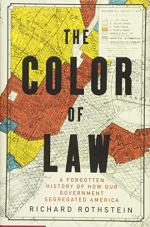
|
| Name: _________________________ | Period: ___________________ |
This test consists of 15 multiple choice questions and 5 short answer questions.
Multiple Choice Questions
1. Where did the American Friends Service Committee (AFSC) find financing for an integrated development?
(a) Private backers.
(b) Metropolitan Life.
(c) Federal government.
(d) California government.
2. What right did the National Labor Relations Act of 1935 give to unions?
(a) The right to strike.
(b) The right to deny membership to African Americans.
(c) The right to get federal work training.
(d) The right to boycott.
3. When was the second Great Migration that brought black families north?
(a) During World War I.
(b) During World War II.
(c) In the 1920s.
(d) In the 1890s.
4. What is a problem Rothstein says that African Americans suffer from as a result of poor housing conditions?
(a) Blindness.
(b) Asthma.
(c) Anemia.
(d) Gout.
5. When does Rothstein say civil rights laws started to be passed in the U.S.?
(a) 1957.
(b) 1968.
(c) 1972.
(d) 1964.
6. What role does Rothstein say churches and synagogues would play in segregation?
(a) Threatening violence against black families.
(b) Advocating racially restrictive covenants.
(c) Raising funds for black families to move into integrated neighborhoods.
(d) Buying up homes before black families could buy.
7. Who does Rothstein say has suffered with African Americans for the injustice of segregation and discrimination?
(a) Asian-Americans.
(b) Native Americans.
(c) Latinos.
(d) All Americans.
8. What did local officials do to prevent the AFSC from building an integrated development?
(a) Raise the cost of the land.
(b) Threaten the builder’s life.
(c) Deny sewer lines to the development.
(d) Add restrictions to house style and color.
9. What excuses does Rothstein say federal officials used to hide the racist consequences of housing policy?
(a) People do not like change.
(b) People were going to live with their own kind.
(c) They were doing what they were elected to do.
(d) They were just making economic decisions.
10. Why did Bob Jones University lose its tax-exempt status in 1976?
(a) For banning inter-racial dating.
(b) For maintaining segregated dorms.
(c) For banning black students.
(d) For professors sleeping with students.
11. What was the Federal Poverty Limit for a family of three, in 2017 when Rothstein published The Color of Law?
(a) $17,000.
(b) $42,000.
(c) $28,000.
(d) $21,000.
12. What makes Rothstein say that real estate agents engaged in blockbusting were engaging in de jure segregation?
(a) They were advocating public policies that supported their trade.
(b) They were appointed by the government.
(c) They swore an oath to uphold the non-discrimination local laws.
(d) They were licensed by state real estate boards.
13. What does Rothstein say was a popular tool for whites who wanted to restrict integrated neighborhoods?
(a) Rezoning them as industrial.
(b) Denying basic services.
(c) Threatening developers’ lives.
(d) Packing the courts to get favorable decisions.
14. What work does Rothstein say black families were largely forced to take after Reconstruction?
(a) Soldiering.
(b) Industrial labor.
(c) Shipbuilding.
(d) Sharecropping.
15. What was Houston’s “Race Restriction Areas” map used for?
(a) De-integrating Houston’s neighborhoods.
(b) Limiting where whites could build.
(c) Integrating Houston’s new developments.
(d) Limiting where blacks could find affordable housing.
Short Answer Questions
1. How does Rothstein characterize the federal, state and local government officials’ racial intent in suppressing African-American wages?
2. What does Rothstein say police knew of, and ignored, in the rioters at Bill Myers’ house?
3. What does Rothstein say African Americans got after the Civil War?
4. How big was the mob that threw rocks at Wilbur Gary’s house?
5. What does Rothstein say whites suffer from as a result of systemic discrimination?
|
This section contains 543 words (approx. 2 pages at 300 words per page) |

|




